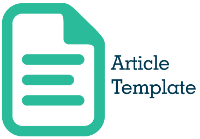Communication Model of Da'wah in Class II-A Penitentiary Pekalongan
Abstract
Prisoners are identical to someone who has committed a crime and is difficult to be accepted again in society. Prisoners are also identical with someone who it difficult to receive messages of kindness, especially messages from preachers. This is different from the Class II-A Penitentiary in Pekalongan, which is very enthusiastic about participating in da'wah activities. The communication model carried out can be well received by prisoners. The purpose of this study is to analyze the communication model used in conducting da'wah to prisoners. This study uses a qualitative research method using purposive sampling, namely preachers, correctional officers, and prisoners. The method of data collection was carried out by in-depth interviews. The results showed that the communication model that was carried out was very good so that it was able to make inmates enthusiastic in participating in these activities. The inhibiting factors in da'wah activities include the busyness of the preacher which makes da'wah cannot be done frequently, the second is environmental factors in prisons that are often exposed to rob, and the third factor is that communication technology has not been optimized to carry out da'wah in correctional institutions.
References
Arifin, B. (2019). Strategi Komunikasi Dakwah Da’i Hidayatullah dalam Membina Masyarakat Pedesaan. Communicatus: Jurnal Ilmu Komunikasi. 2(2): 109–126. https://doi.org/10.15575/cjik.v2i2.4940
Bin Thohir, M. M., & HM, S. H. (2020). Implementasi Komunikasi Organisasi dalam Kegiatan Dakwah untuk Memperbaiki Diri Narapidana di Lembaga Pemasyarakatan Kelas IIB Lumajang. Dakwatuna: Jurnal Dakwah Dan Komunikasi Islam. 6(2): 157. https://doi.org/10.36835/dakwatuna.v6i2.629
Bogiono, J. A. (2021). Wawancara Pengambilan Data.
Dyatmika, T. (2022). Pengaruh Tokoh Agama, Komunikasi Persuasif, Motivasi dan Kognisi Masyarakat terhadap Pelaksanaan Protokol Kesehatan. Jurnal Darussalam: Jurnal Pendidikan, Komunikasi Dan Pemikiran Hukum Islam. XIII(1) 150–172. http://ejournal.iaida.ac.id/index.php/darussalam/article/view/1302
Dyatmika, Teddy. (2021). Ilmu Komunikasi. Zahir Publishing.
Estuningtyas, R. D. (2021). Strategi Komunikasi dan Dakwah Pada Kalangan Milenial di Era Modernisasi. Muttaqien; Indonesian Journal of Multidiciplinary Islamic Studies. 2(01): 75–86. https://doi.org/10.52593/mtq.02.1.05
Izzat, B., & Handaru, W. (2021). Tantangan Agama di Era Globalisasi : Analisis Strategi Komunikasi , Karakteristik dan Materi Dakwah. El Madani. 2(1): 1–24.
Jalaluddin, H. (2009). Psikologi Agama. PT Raja Grafindo Persada.
Munir, M., & Ilaihi, W. (2006). Manajemen Dakwah. Kencana.
Ningtyas, E. S., Gani, A. Y. A., & Sukanto. (2013). Pelaksanaan Program Pembinaan Narapidana Pada Lembaga Pemasyarakatan Dalam Rangka Pengembangan Sumber Daya Manusia (Studi pada Lembaga Pemasyarakatan Klas IA Lowokwaru Kota Malang). Jurnal Administrasi Publik (JAP). 01(06): 1266–1267.
Reksodiputro, M. (2007). Kriminologi dan Sistem Peradilan Pidana (Kedua). Universitas Indonesia.
Slamet. (2009). Efektifitas Komunikasi dalam Dakwa Persuasif. Jurnal Dakwah. 10(2): 179.
Taufik, M. T. (2020). Dakwah Era Digital: Sejarah, Metode dan Perkembangan. Pustaka Al-Ikhlas.
Uchjana, E. O. (2005). Ilmu Komunikasi Dan Praktik. Remaja Rosdakarya.
Wuryansari, R., & Subandi. (2019). Program Mindfulness for Prisoners (Mindfulners) untuk Menurunkan Depresi pada Narapidana. Gadjah Mada Journal Of Professional Psychology. 5(2): 196–212.
Yusuf, Y. M., & Fitrananda, C. A. (2021). Situasi Komunikasi pada Gerakan Dakwah Shift. Linimasa : Jurnal Ilmu Komunikasi. 4(1): 2021. https://www.journal.unpas.ac.id/index.php/linimasa/article/view/3635
Zulkarnain. (2007). Praktik Peradilan Pidana. In-Trans.
Copyright (c) 2022 Translitera : Jurnal Kajian Komunikasi dan Studi Media

This work is licensed under a Creative Commons Attribution-NonCommercial-ShareAlike 4.0 International License.
Authors who publish with this journal agree to the following terms:
- Copyright on any article is retained by the author(s).
- Author grant the journal, right of first publication with the work simultaneously licensed under a Creative Commons Attribution License that allows others to share the work with an acknowledgement of the work’s authorship and initial publication in this journal.
- Authors are able to enter into separate, additional contractual arrangements for the non-exclusive distribution of the journal’s published version of the work (e.g., post it to an institutional repository or publish it in a book), with an acknowledgement of its initial publication in this journal.
- Authors are permitted and encouraged to post their work online (e.g., in institutional repositories or on their website) prior to and during the submission process, as it can lead to productive exchanges, as well as earlier and greater citation of published work.
- The article and any associated published material is distributed under the Creative Commons Attribution-ShareAlike 4.0 International License










